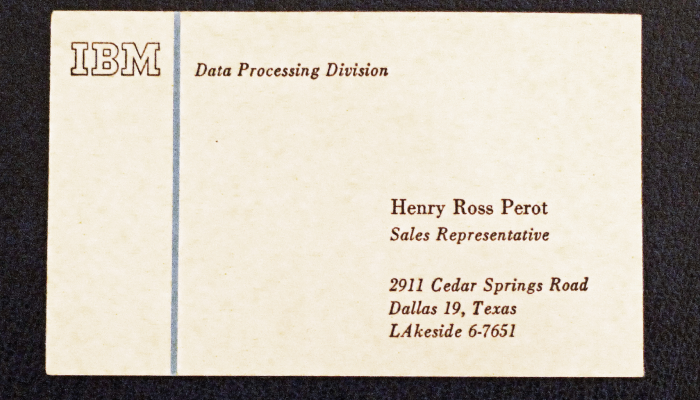
Frank Cespedes teaches at Harvard Business School and for 12 years was Managing Partner at a professional services firm. He has worked with many companies around the world on go-to-market and strategy issues, and has been a Board member at consumer goods, industrial products, services, PE and VC firms. He has written for numerous publications, including Harvard Business Review, European Business Review, Organization Science, California Management Review, and The Wall Street Journal, among others. He is also the author of six books including Aligning Strategy and Sales which was cited as “the best sales book of the year” (Strategy & Business), “a must read” (Gartner), and “perhaps the best sales book ever” (Forbes). His newest book is Sales Management That Works: How to Sell in a World That Never Stops Changing (Harvard Business Review Press).
In our 2022 interview, you mentioned that sales was becoming more data-driven and technology-dependent. Three years later, what's the most significant change you've observed in how B2B sales actually gets done?
Over the past three years, among the biggest factors impacting sales and business development are the end of more than a decade of very low (in real terms, negative) interest rates and the uncertainties spawned by up-and-down tariffs and other factors.
Higher interest rates mean higher cost of capital and the end of growth-at-any-cost, which characterized business development in many industries. It means a return (a welcome return, in my opinion) to profitable-growth sales requirements. Meanwhile, both higher interest rates and uncertainties have lengthened selling cycles in many B2B categories.
Those factors require firms to get better at lead generation and lead qualification. Longer selling cycles increase the costs of chasing false positives—prospects that you spend a lot of time on but that don’t buy. You need to identify a false positive sooner rather than later, because of the reality of opportunity costs in every business. Money, time, and people spent chasing account A are resources not available for accounts B, C, D and so on.
In most companies, these implications pose significant change challenges. Sales metrics usually focus on top-line volume, irrespective of profitability or cost-to-serve different types of customers. So, from the sales force’s perspective, there are no ‘bad’ customers. In many comp plans, sales reps have no incentive to identify a false positive and move on. Doing better, more actionable account reviews becomes a more important sales management activity. Territory assignments and sales deployment often need an overhaul.
The reality is that, if you’re a sales manager, your job has gotten more complex and demanding in the past few years. But when I hear managers complain about this, I always quote that line in the gangster movies: “Remember, you chose this life!”
Every sales tool now claims to have AI features. From your perspective, where is AI actually making a measurable difference in sales outcomes, and where is it just marketing hype?
You are right to use the word ‘hype’. With AI, we are in the early stages of a familiar tech hype cycle. One reason is that AI is now a loose term for many different things, some of which are driven by evolving large-language models and many of which are just using “AI” as a slogan.
That said, the value proposition at the heart of AI is that the tools can do some tasks nearly as good or better than people, freeing-up time for people to do the tasks they do best. In sales, freeing-up time is a big deal.
For example, most salespeople spend less than 50% of their time in actual customer contact. Estimates are 30-35% and this figure includes emails, phone calls, webinars as well as virtual or in-person meetings and demo’s. Consider the impact in a business of increasing time spent prospecting or selling/servicing customers by an incremental 10 – 20%. In most companies, that’s a major productivity boost and it increases the addressable market, because economically infeasible segments become feasible with better go-to-market utilization. There are AI tools that save much time in content marketing, personalizing emails, helping salespeople find information about the industry, company and people they meet, and practice sales conversations. If you are not using these tools, watch what your competitors do with them.
Similarly, when it comes to lead gen and qualification, AI tools can help to identify and clarify the relevant parameters and often with more market accuracy than the folk wisdom driven by the firm’s sales compensation incentives. This is another big deal because in most firms the selling cycle is the biggest determinant of time-to-cash, working-capital requirements, and funding needs. Especially in B2B markets with multiple RFPs and pre-sale customization requirements, this ability is crucial to allocating available business-development resources efficiently.
There are AI tools that help marketers and salespeople understand traits common to your current “best” customers, identify segments that have been over-looked, and use that information to generate (via the AI tool) tailored content, posts, landing pages, and outreach questions that improve lead qualification earlier in the selling cycle. And all of this with less human effort spent in research and data retrieval and, over time, reduced cost-to-serve.
However, I’m old enough to remember business “reengineering” initiatives in the 1990s. The slogan then was “don’t just use technology to pave the cow paths.” That remains true with AI. If your sales model is not relevant or reaching diminishing returns because buying patterns have changed, no amount of AI will help.
Focus first on sales process, and then AI tools. Without up-to-date understanding of how target customers make decisions today (not yesterday), you won’t know where AI capabilities can make a difference. And that understanding is a management, not a technology issue. Without it, AI easily becomes a tool without a real use-case or just another cost of doing business.
Cold email deliverability has tanked, LinkedIn is saturated, and buyers are harder to reach than ever. What channels or approaches are you seeing work for prospecting in 2025?
“What goes around comes around,” and that’s always true with marketing media. A decade ago, many organizations cut resources for email campaigns in favor of SEO and other search media. Then, as the pandemic made online search a very crowded and expensive medium, they flooded customers with emails again.
That cycle should be expected and anticipated. Current best practices will always be imitated and, as that practice saturates a given medium, the ROI of that approach inevitably declines. That’s called competition. Good managers know how to track diminishing returns and move on to an approach that generates better ROI for some time.
For example, my experience with companies is that email, when targeted at the right prospects at the right time in the buying cycle, is still a relatively effective medium. But as technology makes email blasts such an easy thing to do, many sales people use it indiscriminately and, in effect, train their customers to treat their emails as spam.
In addition, as I’ve argued in my own research and books (and in our 2022 interview), sales is a context-specific business activity. Selling software differs from selling capital goods which differs from selling professional services. Selling in the U.S. differs from selling in Asia which differs from selling in Latin America or the Middle East. And even within the same geography and category, customers differ not only in their preferences for products and services—the basis for market segmentation—but also in how they want to interact via email or webinar or in-person, and so on. The job of the sales person is to understand those differences in their customer base and then use, or not use, the relevant tool, whether it’s email, LinkedIn, the phone or whatever.
By contrast, searching for some secret-sauce, all-purpose tool or approach is, in my view, a sucker’s game. What’s the managerial implication? Go back to basics: do we know who our target customer is and is not? have we developed an Ideal Customer Profile (ICP) that helps sales people prioritize prospecting criteria, call patterns, and communications media?
I suggested a process for developing an ICP in a book I wrote a decade ago, Aligning Strategy and Sales. I think that advice remains as relevant as ever. In fact, the process itself typically has value: it helps to establish a common language and shared vision across product, marketing, and sales functions which generates benefits in areas beyond email or LinkedIn expenditures.
We’re seeing more companies form ‘revenue teams’ rather than separate sales and marketing departments. What does good GTM organizational structure look like in 2025?
Let’s first make some distinctions. Language changes all the time in business. Calling a Sales VP a Chief Growth Officer often means no real change in role, responsibilities, or performance. And using “Revenue Team” to refer to the same interactions between sales and marketing people also often makes little difference. Moreover, “structure” is not the same as “organization,” and shuffling org charts is a ritual which often leads to a merry-go-round without impact.
To construct a good (that is, effective) org structure, consider two things:
The first, and most important, is whether your sales model—how you allocate selling efforts based on implicit or explicit choices--is relevant to current market conditions and buying criteria in your category. In my experience, most companies’ sales models are the accumulation of years of reactive decisions, usually by different managers pursuing different goals. Market forces and buying changes increasingly expose the loose screws.
Notice what happens over a market life cycle. Customers typically start as generalists and thru usage become more sophisticated and discriminating. As standards evolve and competitors enter, buyers have more choices and can take more for granted in quality or performance attributes across vendors. If firms fail to adjust, they lose competitive advantage and the relevance of their sales models. This dynamic has played out many times, dislodging seemingly impregnable firms from market leadership positions. Think about the current impact of AI on search and Google’s position in digital advertising.
Second, many new technologies, including but not only AI, are increasing the interdependence between marketing and sales groups. The tech also allows sales groups to do things that, a few years ago, would have been a marketing task. Consider content marketing or email campaigns aimed at lead generation. In many SaaS sales models, software allows relatively inexperienced SDRs (Sales Development Reps) to do this activity cheaply and often. The issue is, do they know what they’re doing and does it serve profitable growth?
Managers can’t develop an effective organizational structure until they address those core sales-model questions. Peter Drucker once said that the purpose of an organization is to enable ordinary people to do extraordinary things. He was right. Structure, in sales and other parts of a company, should serve initiatives aimed at harnessing talent to increase enterprise value.
If you were coaching a new sales rep starting today, what would you tell them to focus on that will still matter in five years?
Any sales organization has people with different capabilities and approaches. A manager must adapt feedback to individuals and their behaviors in relation to key tasks in that sales model. Coaching is about clarifying the relevant behaviors and diagnosing whether the issue is motivation or ability. Some reps may work hard, but lack certain capabilities: can training enhance those skills? Others demonstrate capability but may lack motivation or effort: are their abilities better utilized in a different role, or is there an incentive that can increase smart effort in their current role? In other words, a one-size-fits-all approach is rarely effective.
Also, during the course of a week or even a day, most salespeople, especially in B2B, deal with different buying contexts. A customer for rebuys may not need the information required by a new purchaser. Within the same product category, one buyer is primarily concerned with innovative features, while another is concerned with just-in-time delivery. Selling a new solution means different tasks than selling an existing solution at an account. It’s not the responsibility of customers to adapt to a salesperson; it’s the salesperson’s responsibility to adapt to customers.
So, especially for a new sales rep, I would emphasize the basics: make sure you listen hard to what your customers say and don’t say, register the important differences, and act accordingly. If all customers sound the same to you, do not try to make a living in sales; do something else, you’ll make more money.
We measure everything in sales now, but what important aspects of selling can't be measured and why does that matter?
Personal relationships still matter in B2B selling, and it’s hard to measure that. In an omni-channel, information-abundant buying world, it’s hard to measure attention. Clicks or time on a site are deceptive measures of attention, but attention counts. Finally, “brand equity”—the influence of a brand in motivating purchases--is notoriously difficult to measure.
However, the flip-side of your question may be more important. The good news is that the ability to measure more activities can increase transparency. The ability to track more sales activities means more opportunities for continuous improvement in a well-managed sales force, and the measures generate more incentive to improve.
The bad news is how metrics are often used. In many firms, it’s like the old joke about the drunk under the lamppost. One night you see an inebriated man searching for his keys under the only lamppost on a street. You want to help and ask, “Where did you drop your keys?” He says, “About 300 hundred feet back there.” “Then why are you looking here?” “Because this is where the light is.” Consider how much talk about sales metrics essentially does this: a focus on data factoids independent of context.
In business, interpreting data and using metrics effectively requires dialogue with the people who use the data and are evaluated with those metrics. You must place the data and metrics in context in order to understand how much is the salesperson, the market, incentive systems, or other factors that you can control, alter, or mitigate.
If you could eliminate one common sales practice that everyone thinks is essential, what would it be?
Allow me to flip-the-script here and comment on an essential sales practice that too often does get eliminated or done sloppily: performance reviews.
Sales outcomes are a lagging indicator and susceptible to multiple interpretations, only some of which are empirically true in your context. You want people focused on the correct causal relationships in your sales model, not enacting the natural human tendency to ascribe credit for good outcomes to oneself and the causes of bad outcomes to someone or something else.
Also, notice what happens in the absence of performance feedback. Many people will assume that no news is good news. If managers are not clear about priorities, people often then spend time and effort on things with an ad hoc, hit-and-miss relationship to performance. And if you believe, as I do, that people seek recognition as well as money in their jobs, absence of feedback inhibits that as well.
Finally, in most B2B sales contexts, key information about how buying really works at specific customers is not in the CRM system. It’s in the heads of individual account managers, and only becomes visible and actionable through good performance reviews.
All of these things make performance conversations essential. But many busy sales managers either omit reviews or do quickie, drive-by reviews with their people. When they do this, those managers not only perpetuate a culture of under-performance in their sales teams, they also inhibit the flow of vital market information to the rest of the organization.







